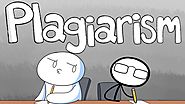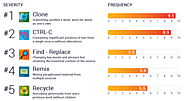-
About
- About Listly
- Community & Support
- Howto
- Chrome Extension
- Bookmarklet
- WordPress Plugin
- Listly Premium
- Privacy
- Terms
- DMCA Copyright
- © 2010-2025 Boomy Labs


 Bhavna Pithamber
Bhavna Pithamber
Listly by Bhavna Pithamber
A little list on 5 things you should know about plagiarism- as told by others on the web
You are welcome to add your perspective :)
This list is made for ISTN731

Plagiarism is not just copying the words of others. Using the ideas, facts and information of others and passing them as your own is also Plagiarism.
In this video...
Accompanied by humorous illustrations and narrations, the creator of this video talks about his experiences with plagiarism and the amusing repercussions he faced.

So how exactly does plagiarism present itself?
This infographic explains the various forms plagiarism takes and the frequency with which it occurs. This data was made available by a popular plagiarism detection tool TurnItIn.
Producing an exact copy of someone else's idea or work leads this list. This is known as Clone and it occurs 95% of the time. Using the proper referencing format but having a sentence that similar to the original is the least severe form of plagiarism. This is known as
Re-tweet and its frequency level is 44%!
The most occurring form of plagiarism is Clone with a 95% frequency rate and the least occurring is Hybrid with 5%. Hybrid is a mixture of well-cited sources with plagiarised content.

Knowledge gained must be shared and evolved and to do this knowledge must be gained from other people. Therefore it is acceptable to utilise the work of others only if it is clearly indicated that it is someone else's work.
This infographic goes through 4 steps to ethical plagiarism. These are Paraphrasing, Referencing, Investing and Checking Early.
Paraphrasing means expressing the work of someone else in your own words. Referencing notes where the quoted/paraphrased material comes from.

The previous source lists Investigation as part of the ethical plagiarism process. A form of investigation is using an online plagiarism detection service such as TurnItIn.
TurnItIn detects how original submitted text is by comparing it to other sources. It produces an originality percentage of the paper submitted and this is used by institutions and people to detection the level of plagiarism a paper has. TurnItIn operates through its website which could be found here
This video introduces you to TurnItin and explains some of its features.

Plagarism Detectors aren't just used for academic use. It is revealed that plagarism software can also be used to analyse historical documents and determine their sources.
This article reveals how TurnItIn was used to detect plagiarism in Shakespeares' plays!!
Plagarism software ... (has) ... uncovered a long-forgotten, handwritten document from 1576 as the possible source for more than 20 monologues and passages from Shakespeare’s plays.
This discovery has received raised eyebrows from many. Their arguments complicates the concept of plagiarism. Plays consist of settings, background stories and language details which is very different from words. How does one prove that a location has been plagiarised?
